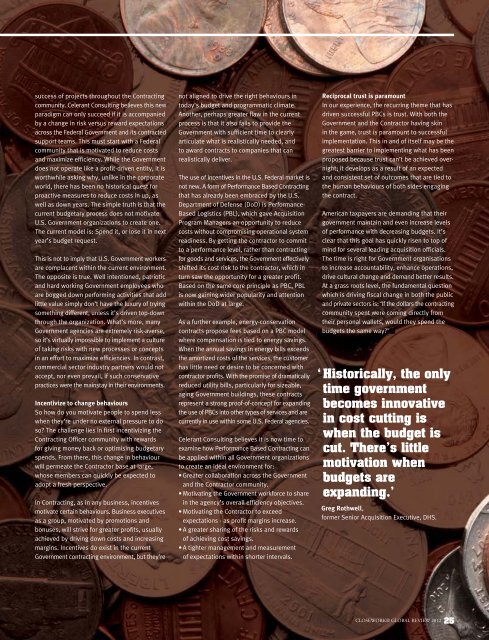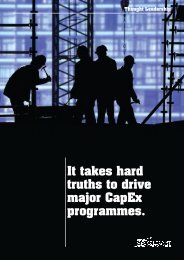download - Celerant Consulting
download - Celerant Consulting
download - Celerant Consulting
- No tags were found...
You also want an ePaper? Increase the reach of your titles
YUMPU automatically turns print PDFs into web optimized ePapers that Google loves.
success of projects throughout the Contractingcommunity. <strong>Celerant</strong> <strong>Consulting</strong> believes this newparadigm can only succeed if it is accompaniedby a change in risk versus reward expectationsacross the Federal Government and its contractedsupport teams. This must start with a Federalcommunity that is motivated to reduce costsand maximize efficiency. While the Governmentdoes not operate like a profit-driven entity, it isworthwhile asking why, unlike in the corporateworld, there has been no historical quest forproactive measures to reduce costs in up, aswell as down years. The simple truth is that thecurrent budgetary process does not motivateU.S. Government organizations to create one.The current model is: Spend it, or lose it in nextyear’s budget request.This is not to imply that U.S. Government workersare complacent within the current environment.The opposite is true. Well intentioned, patrioticand hard working Government employees whoare bogged down performing activities that addlittle value simply don’t have the luxury of tryingsomething different, unless it’s driven top-downthrough the organization. What’s more, manyGovernment agencies are extremely risk-averse,so it’s virtually impossible to implement a cultureof taking risks with new processes or conceptsin an effort to maximize efficiencies. In contrast,commercial sector industry partners would notaccept, nor even prevail, if such conservativepractices were the mainstay in their environments.Incentivize to change behavioursSo how do you motivate people to spend lesswhen they’re under no external pressure to doso? The challenge lies in first incentivizing theContracting Officer community with rewardsfor giving money back or optimising budgetaryspends. From there, this change in behaviourwill permeate the Contractor base at large,whose members can quickly be expected toadopt a fresh perspective.In Contracting, as in any business, incentivesmotivate certain behaviours. Business executivesas a group, motivated by promotions andbonuses, will strive for greater profits, usuallyachieved by driving down costs and increasingmargins. Incentives do exist in the currentGovernment contracting environment, but they’renot aligned to drive the right behaviours intoday’s budget and programmatic climate.Another, perhaps greater flaw in the currentprocess is that it also fails to provide theGovernment with sufficient time to clearlyarticulate what is realistically needed, andto award contracts to companies that canrealistically deliver.The use of incentives in the U.S. Federal market isnot new. A form of Performance Based Contractingthat has already been embraced by the U.S.Department of Defense (DoD) is Performance-Based Logistics (PBL), which gave AcquisitionProgram Managers an opportunity to reducecosts without compromising operational systemreadiness. By getting the contractor to committo a performance level, rather than contractingfor goods and services, the Government effectivelyshifted its cost risk to the contractor, which inturn saw the opportunity for a greater profit.Based on the same core principle as PBC, PBLis now gaining wider popularity and attentionwithin the DoD at large.As a further example, energy-conservationcontracts propose fees based on a PBC modelwhere compensation is tied to energy savings.When the annual savings in energy bills exceedsthe amortized costs of the services, the customerhas little need or desire to be concerned withcontractor profits. With the promise of dramaticallyreduced utility bills, particularly for sizeable,aging Government buildings, these contractsrepresent a strong proof-of-concept for expandingthe use of PBCs into other types of services and arecurrently in use within some U.S. Federal agencies.<strong>Celerant</strong> <strong>Consulting</strong> believes it is now time toexamine how Performance Based Contracting canbe applied within all Government organizationsto create an ideal environment for:• Greater collaboration across the Governmentand the Contractor community.• Motivating the Government workforce to sharein the agency’s overall efficiency objectives.• Motivating the Contractor to exceedexpectations - as profit margins increase.• A greater sharing of the risks and rewardsof achieving cost savings.• A tighter management and measurementof expectations within shorter intervals.Reciprocal trust is paramountIn our experience, the recurring theme that hasdriven successful PBCs is trust. With both theGovernment and the Contractor having skinin the game, trust is paramount to successfulimplementation. This in and of itself may be thegreatest barrier to implementing what has beenproposed because trust can’t be achieved overnight;it develops as a result of an expectedand consistent set of outcomes that are tied tothe human behaviours of both sides engagingthe contract.American taxpayers are demanding that theirgovernment maintain and even increase levelsof performance with decreasing budgets. It’sclear that this goal has quickly risen to top ofmind for several leading acquisition officials.The time is right for Government organisationsto increase accountability, enhance operations,drive cultural change and demand better results.At a grass roots level, the fundamental questionwhich is driving fiscal change in both the publicand private sectors is: ‘If the dollars the contractingcommunity spent were coming directly fromtheir personal wallets, would they spend thebudgets the same way?’‘ Historically, the onlytime governmentbecomes innovativein cost cutting iswhen the budget iscut. There’s littlemotivation whenbudgets areexpanding.’Greg Rothwell,former Senior Acquisition Executive, DHS.CLOSEWORK® GLOBAL REVIEW 2012 25








